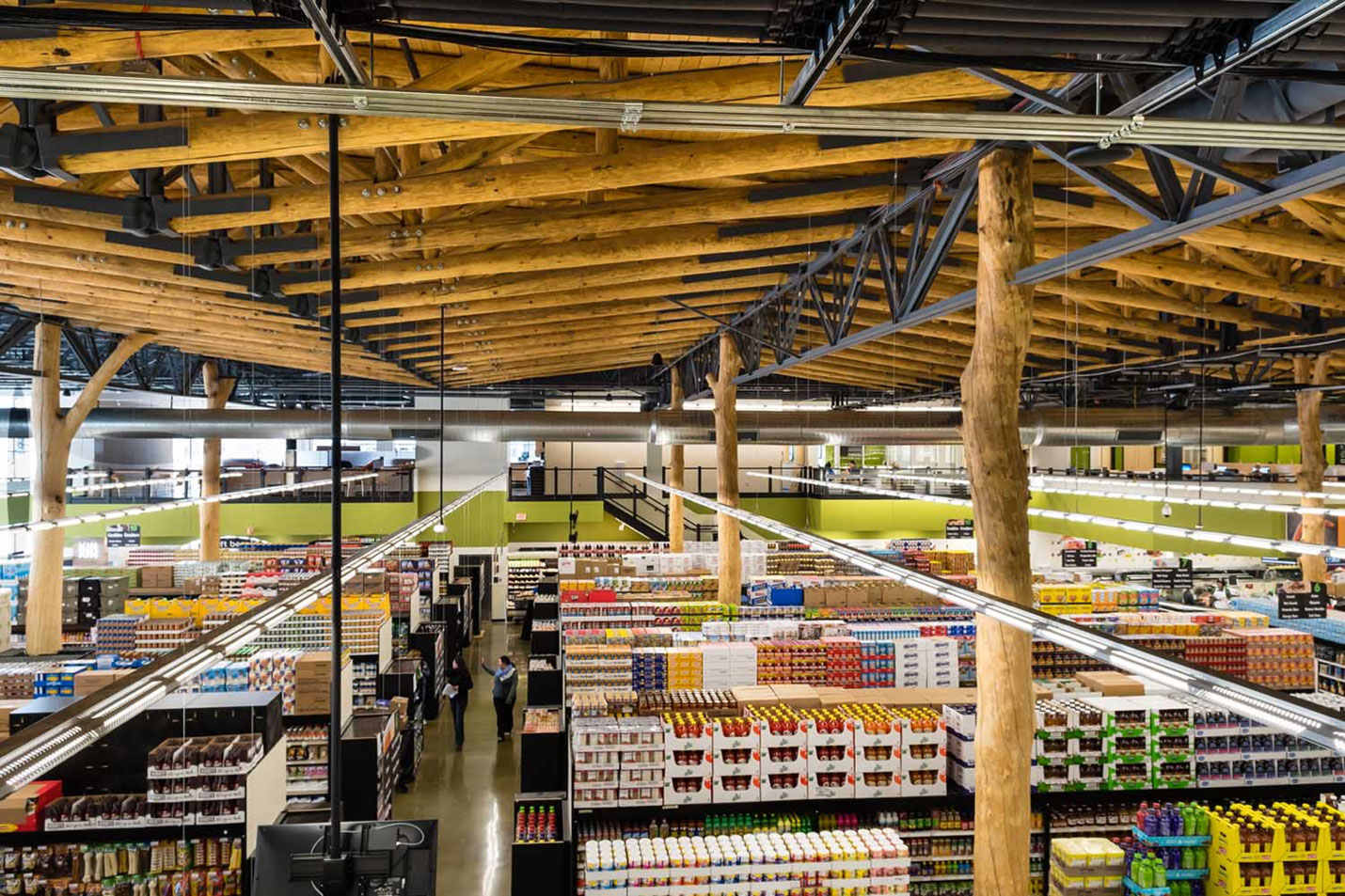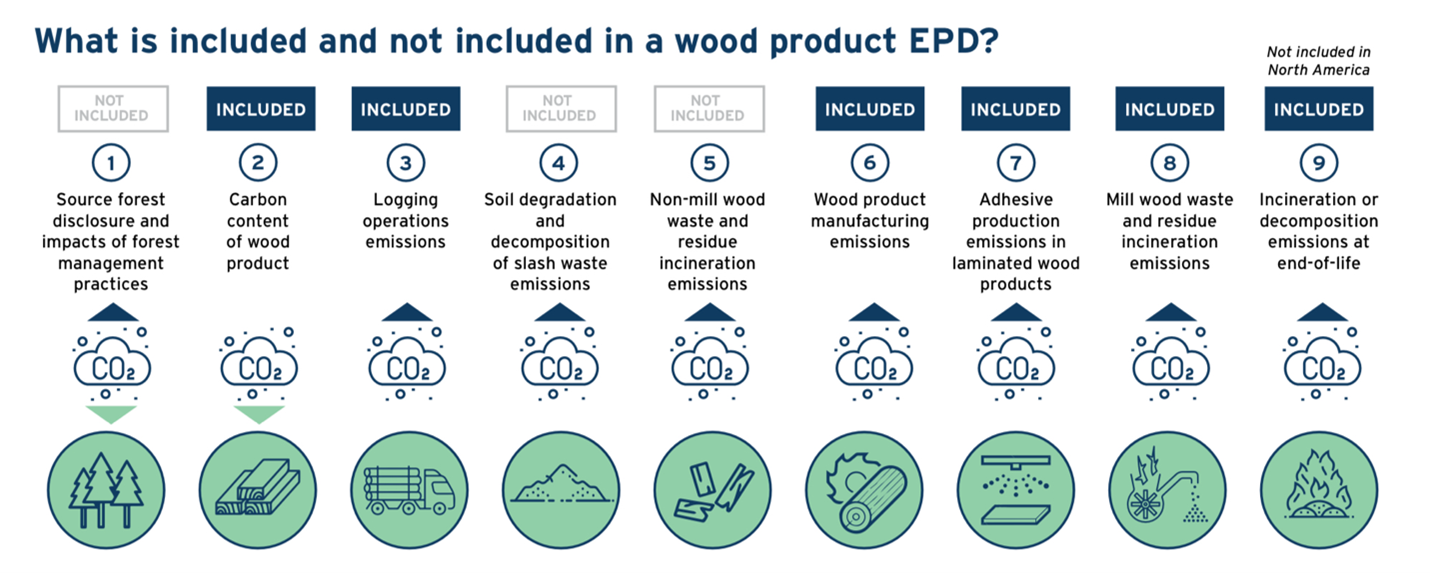To the casual observer, the ash trees standing in the Festival Foods grocery store in Madison, Wisconsin, may look decorative. In fact, these trees, salvaged from an ecologically motivated harvest in a nearby urban forest, are structural. They are emblematic of a growing design movement which puts wood in buildings to work in service of forests, communities, and climate.
When the City of Madison felled ash trees in a city park as part of a campaign to limit the spread of the emerald ash borer, WholeTrees Structures used 3D scanning and minimal manual processing to turn these trees into primary structural columns. In this masterful application of systems thinking and frugal design, the design team used trees that would have otherwise been processed into wood chips or firewood as columns in place of high embodied carbon steel or concrete. This is far from an isolated example. Such “form follows forest” design approaches are gaining traction globally.
But is all wood “good”? As the public discourse on the sustainability of wood products grows, designers would like to know: can wood products used in buildings really benefit the climate? As the answer to all important design decisions should be, it depends. Furthermore, forests are deeply implicated in human society beyond their relationship with the climate. Whenever possible, designers should use creative systems thinking to discover the right ways to use the right amounts of the right wood on each project. What is “right wood”? Designers should proactively engage with forest experts, wood products specialists, and local and Indigenous communities to co-create answers. Here are 10 questions to ask when getting started:
How should we manage our forests for a challenging future?
Forests provide humans with numerous benefits, including (among many others) clean water, carbon sequestration and storage, habitat, recreation, wood products, non-wood products, and cultural value. Although some of these benefits are not explicitly valued in the economy, many are literally priceless—there is no known alternative at any cost.
Climate change and invasive species increase the risk of “natural” forest disturbances such as wildfire, storms, disease, and insect attack, which threaten forests’ ability to provide these benefits. In addition to acute disturbances, the climate is likely to change faster than forests can adapt, meaning many living trees will find themselves outside of the conditions they are best suited to grow in. Experts agree that proactive management is necessary to help forests adapt. Active forest management can take many forms, including plantation forestry and interventions in naturally regenerating forests. Designers should engage forest experts to understand the challenges and opportunities in sustainable forest management on this changing planet.
2. What are Indigenous peoples’ perspectives?
Humans have been shaping three quarters of terrestrial nature since at least 12,000 years ago. During colonization, Europeans justified domination and displacement of Indigenous peoples worldwide by calling their lands “wild”. Today, conservation approaches often continue to invoke the wilderness myth, excluding Indigenous people from their lands based on the misguided belief that any human presence in a landscape is harmful. In fact, Indigenous people manage some of the most bio-diverse landscapes on the planet, and their cultural practices actively contribute to this abundance. Indigenous forestry practices, including commercial harvest, can lead to both high quality wood products and resilient forest ecosystems.
Some of the U.S.’s greatest forest management challenges arose directly from colonizers’ displacement of Indigenous land management practices. Western U.S. forests are overstocked with small-diameter trees, which, combined with changing weather due to climate change, increases the risk of destructive megafires. This overstocking is the result of decades of fire suppression in the 20th century, a practice that replaced millennia of low-intensity cultural forest burning by Indigenous people. Today, the U.S. Forest Service engages with tribal partners through co-stewardship agreements. When asking what is “right wood”, designers should ask for and center Indigenous peoples' perspectives.
3. How could using wood in buildings help pay for sustainable forest management?
Managing forests is expensive. It currently costs the U.S. Forest Service between roughly $750 and $4,000 per acre to thin forests to reduce the risks of high-intensity wildfire. Since 2022, the federal government has committed $930 million dollars to forest thinning treatments. The small-diameter trees harvested through thinning have little to no market value, meaning they are often left in the forest to decompose, or they are burned. A number of innovative designers and manufacturers are commercializing the use of wildfire thinnings and other under-valued small-diameter timber in buildings. This practice uses these byproducts of sustainable forest management in place of steel and concrete products with higher embodied carbon, while providing revenue to landowners to offset the costs of thinning. By “eating the problem”, Timber Age Systems, Vaagen Timber, PathHouse, SmartLam, and many others are putting buildings and building products to work in service of sustainable forest management.
U.S. forests face diverse and costly challenges, many of which require harvest to address. Designers should work with forest experts to understand local sustainable forest management needs and create high-value applications for harvested wood that could support these practices.
4. How could using wood in buildings help pay to keep forests forests?
Harvest is not deforestation. Deforestation is the permanent change of forest land to another use. Economic pressure to convert forests to other more profitable land uses, especially agriculture, has driven substantial deforestation in the Global South in recent decades. In the U.S., suburban development is a key competing land use for forests.
Sale of timber from harvests can, in some instances, be an important revenue stream for forest landowners. This is especially true when owners are insufficiently compensated for the ecosystem services provided by their forests. When landowners believe that the net present value of their land is highest as forest, they are less likely to convert it to other uses. Designers should engage with local forest landowners to understand the economic drivers influencing their land-use decisions, and how the use of wood products in high-value applications could help prevent deforestation. Engaging directly with landowners could also help to reduce the risk of “red list” scenarios such as illegal logging and permanent deforestation.
5. How can “form follow forest”?
The use of wildfire thinnings in wood products is just one example of many synergistic relationships among forests, people, and the built environment that can be unlocked when designers engage with forest experts, wood products specialists, and local and Indigenous communities. An estimated 36 million trees are felled in urban areas throughout the U.S. each year. Cambium Carbon works with arborists and local municipalities from around the country to locate such fallen trees and process them into building materials.


